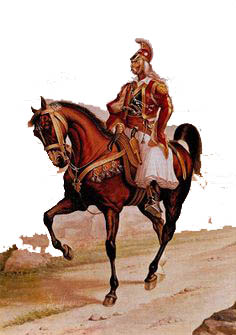The National Assemblies and the Political Organization
of the Struggle
6th Grade History (Chapter 16)
Greek Revolution against the Ottoman Turks (Greek educational system)
Revolutionary for a Day
|
|
Materials for the lessonTeacher comes to class with name tags representing the different ‘forces’ within the Greek revolutionaries. Name tags include “Islanders”, “Peloponnesian Military” ,“Sterea Ellas (Rumeli) Military”, “Prokritoi (Notables) of Peloponnese”, “Prokritoi of Sterea Ellas” “Merchants” etc.Teacher brings along copies of the first three Constitutions of the new state, namely the ones adopted in Epidaurus, 1821, in Astros of Arcadia, 1823 and in Trizina, 1827 respectively. |
Layout of the classroomDesks are moved to the side. Chairs form an amphitheater. Teacher aims at creating a space to be used by an assembly of representatives. |
|
Phase 1Students have already covered a great part of the Greek revolution of 1821. They are familiar with the differences among the different political forces within the Greek camp as well as the role foreign powers played (England, France, Russia and Austrian-Hungarian Empire).Students pick at random a name tag and thus become members of a specific ‘political group’. Military figures, notables, Islanders, as well as individuals-personalities like Mavrokordatos, Kolletis and Kolokotronis can be some of them. Students now form groups based on their name tags and they sit accordingly. |
|
Phase 2Teacher asks each group to identify passages in the textbook (or other primary or secondary sources the class has used in previous meetings) with relevance to their adopted role. These passages should help the students understand the motivation as well as the vision its group of individual had for the national cause.In particular students should try to give answers to the following questions:How each group responds to the question for a more centralist or a decentralized Greek state?How each group’s particular interests coincide with or go against those of foreign powers?Students work in their groups and are advised to spot or come up with key terms as they conduct their ‘research’. They select who among them will present their findings. |
|
Phase 3Students present the key characteristics of each group. All students may ask questions. Students are asked to identify what divides and what brings together all the ‘actors’ of the revolution.Students are then given some time to prepare short ‘presentations’ with the positions of each group. |
|
Phase 4In this last phase, students are given the floor to present to the ‘assembly of representatives’ what they think is appropriate for the constitution and the political organization of the Greek state.Presentations are encouraged to start by self-identification (“my name is… and I am a merchant from Odessa…” or “my name is… and I have been fighting all long the revolution with around 200 young men from…”). |


 SmartOWL
SmartOWL